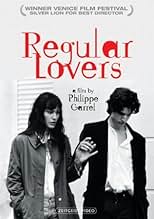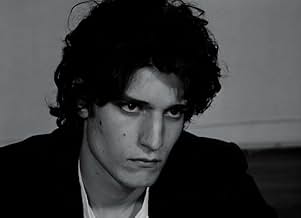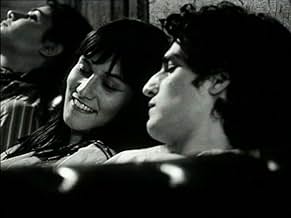Les amants réguliers
- 2005
- 3h 3m
IMDb RATING
6.8/10
3.1K
YOUR RATING
Amidst the chaos of student and union protests, 20-year-old Parisian poet François finds himself in legal hot water for dodging a stint in the French military. While at a party, he falls in ... Read allAmidst the chaos of student and union protests, 20-year-old Parisian poet François finds himself in legal hot water for dodging a stint in the French military. While at a party, he falls in love with Lilie, a would-be sculptor.Amidst the chaos of student and union protests, 20-year-old Parisian poet François finds himself in legal hot water for dodging a stint in the French military. While at a party, he falls in love with Lilie, a would-be sculptor.
- Director
- Writers
- Stars
- Awards
- 7 wins & 5 nominations total
- Director
- Writers
- All cast & crew
- Production, box office & more at IMDbPro
Featured reviews
The reason I am reviewing this is that the previous review, was written by someone who walked out of this film, not even half way through. Unfortunately for him, he missed out on a film of tremendous beauty. Agreed the film was very slow to start, in fact the friend I was with fell asleep briefly,I woke him before his snoring disturbed the rest of the audience. Thankfully the film developed from there into a story of love, drugs and what it was like to be young and free in the experimental 60s. Fantastic performances from the two leads and a great look to the film that gave it a real authentic feel. Be patient, like many great films its well worth the wait, and is certainly a film that I will look forward to revisiting! 8/10
Seeing Les Amants Reguliers calls immediately for comparison with Bertolucci's movie 'The Dreamers', in my opinion the best film made about the 1968 revolt of students in Paris. Actually director Philippe Garrel does not seem to avoid comparing with his much more famous colleague, sharing the principal actor and even including a direct replica eye-in-viewer-eye about an older film of Bertolucci. And yet, LAR is a different film, and an interesting one.
The story line seems also familiar. The movie starts with long scenes of the 1968 'emeutes', maybe among the best done until now. The film is made in black-and-white, and the perspective of the static camera on one side or the other of the barricade reminds Eisenstein. Then, as in The Dreamers, the action moves in the Parisian flat where the heroes of the defeated revolt make art, smoke drugs, dream, and fall for one other. There is no direct social comment, no real explanation of the background of the revolt. The movie focuses on the psychology of the characters and on the love story between the main characters. It's like a premonition of the process of transition to the establishment that the generation of the 1968 went through, it's just that not all the participants may adapt or survive.
The film is more about the characters than about the events. And it is merely for the style it will be remembered about. The black-and-white cinema is memorable not only in the revolution scenes, but also when looking at the characters evolution. Many sequences are enhanced by a technique that is derived from the silent films movies, with long takes accompanied by a off piano tune. The effect is exquisite. Yet the length of the film is hardly justified, it lasts more than three hours and I doubt that cutting it to only two hours would have been a miss - actually I am convinced it's quite a contrary.
Without raising at the depth and subtlety of Bertolucci's movie LAR is another perspective to remember about one of the more important years in the history of France and of the world in the 20th century.
The story line seems also familiar. The movie starts with long scenes of the 1968 'emeutes', maybe among the best done until now. The film is made in black-and-white, and the perspective of the static camera on one side or the other of the barricade reminds Eisenstein. Then, as in The Dreamers, the action moves in the Parisian flat where the heroes of the defeated revolt make art, smoke drugs, dream, and fall for one other. There is no direct social comment, no real explanation of the background of the revolt. The movie focuses on the psychology of the characters and on the love story between the main characters. It's like a premonition of the process of transition to the establishment that the generation of the 1968 went through, it's just that not all the participants may adapt or survive.
The film is more about the characters than about the events. And it is merely for the style it will be remembered about. The black-and-white cinema is memorable not only in the revolution scenes, but also when looking at the characters evolution. Many sequences are enhanced by a technique that is derived from the silent films movies, with long takes accompanied by a off piano tune. The effect is exquisite. Yet the length of the film is hardly justified, it lasts more than three hours and I doubt that cutting it to only two hours would have been a miss - actually I am convinced it's quite a contrary.
Without raising at the depth and subtlety of Bertolucci's movie LAR is another perspective to remember about one of the more important years in the history of France and of the world in the 20th century.
10lallet
This film is probably the best new French film I've seen in this century so far. There have been some great ones including Noe's Irreversible, Green's Le Pont des Arts and Hadzihalilovic's Innocencebut none of them come close to Les Amants Reguliers' timeless glory.
The movie is a description of the events of May 68 and what followed in the wake of it and furthermore it is and update of, and a homage to, the Nouvelle Vague-movies of those days. Concerning the depiction of the riots in Paris the movie is meticulously accurate (I'm only 19 and I wasn't there myself but you know what I mean)and the almost real-time and very long riot scenes set the stage perfectly for the aftermath of the events in the streets of Paris. The riots are not glorified or beautifully photographed like the ones in Bertolucci's The Dreamers (to which the movie is comparable in many ways) instead they are filmed in grimy black and white shots courtesy of the excellent William Lubtchansky. The love story that is the movie's main concern after the riots in 68 is filmed in stunning and far less blurred shots and manages to evoke true feelings of love and adolescent confusion in the midst of the otherwise politically concerned and seemingly cold environment.
This film is a beautiful love story and it radiates through it that the director wants to depict his own experiences of those mythical late 60's which makes the film all the more compelling. But the film is also a homage to the whole Nouvelle Vague canon. Much of the dialogue evokes early Truffaut, and the length and non-action and plot less structure is reminiscent of Eustache or Rivette. There are even Godard-like verfremdung-effects with the persons looking directly into the camera and even addressing Bernardo Bertolucci directly. This film is no doubt an answer song to Bertolucci's The Dreamers and it is also a Nouvelle Vague homage but still it stands by itself as a beautiful and radiant love story.
Bottom line: This movie is incredible and if you love French cinema you shouldn't sleep on it. It may be the finest french film since Eustache's La Mamain et la Putain.
The movie is a description of the events of May 68 and what followed in the wake of it and furthermore it is and update of, and a homage to, the Nouvelle Vague-movies of those days. Concerning the depiction of the riots in Paris the movie is meticulously accurate (I'm only 19 and I wasn't there myself but you know what I mean)and the almost real-time and very long riot scenes set the stage perfectly for the aftermath of the events in the streets of Paris. The riots are not glorified or beautifully photographed like the ones in Bertolucci's The Dreamers (to which the movie is comparable in many ways) instead they are filmed in grimy black and white shots courtesy of the excellent William Lubtchansky. The love story that is the movie's main concern after the riots in 68 is filmed in stunning and far less blurred shots and manages to evoke true feelings of love and adolescent confusion in the midst of the otherwise politically concerned and seemingly cold environment.
This film is a beautiful love story and it radiates through it that the director wants to depict his own experiences of those mythical late 60's which makes the film all the more compelling. But the film is also a homage to the whole Nouvelle Vague canon. Much of the dialogue evokes early Truffaut, and the length and non-action and plot less structure is reminiscent of Eustache or Rivette. There are even Godard-like verfremdung-effects with the persons looking directly into the camera and even addressing Bernardo Bertolucci directly. This film is no doubt an answer song to Bertolucci's The Dreamers and it is also a Nouvelle Vague homage but still it stands by itself as a beautiful and radiant love story.
Bottom line: This movie is incredible and if you love French cinema you shouldn't sleep on it. It may be the finest french film since Eustache's La Mamain et la Putain.
It's not like an historical movie, it's not a movie with unforgettable love stories, it's not a movie with a spectacular scenario, but i can surely say it's a movie with a great atmosphere...
It had that 60's kind of bohemian and rebellious spirit: a group of friends living in a poor apartment in Paris, each one making art, dreaming of changing the world, doing drugs and loving in his very own way.
It takes a lot of patience to watch, and a special mood, that if you're not in, you might find it extremely boring and dull.
I liked a lot the very realistic approach of the events that took place and their immediate effect on student's lives: the fear for their future, the difficulty of earning their living, the obstacles in following their dreams.
What i absolutely loved was the black & white image. The still camera angles were amazing, they were like freezing moments. It left me the impression of a long slide show of old and very emotive and suggestive photographs. I actually had to see the movie again, just to take those amazing screen-shots.
In one word: beautiful...
It had that 60's kind of bohemian and rebellious spirit: a group of friends living in a poor apartment in Paris, each one making art, dreaming of changing the world, doing drugs and loving in his very own way.
It takes a lot of patience to watch, and a special mood, that if you're not in, you might find it extremely boring and dull.
I liked a lot the very realistic approach of the events that took place and their immediate effect on student's lives: the fear for their future, the difficulty of earning their living, the obstacles in following their dreams.
What i absolutely loved was the black & white image. The still camera angles were amazing, they were like freezing moments. It left me the impression of a long slide show of old and very emotive and suggestive photographs. I actually had to see the movie again, just to take those amazing screen-shots.
In one word: beautiful...
Philippe Garrel makes us breathe the forgotten atmosphere of the Nouvelle Vague, almost lost among the vestiges of its ancient splendor but ready to rise again from its ashes if recalled from the past. They who are a little acquainted with the director's subjects, on the other hand, may know very well how he's obsessed by a lingering sense of loss as far as fickleness of reality is concerned. "Les amants réguliers", therefore, show us the parallel stories of an "amour fou" and of a tempted revolution gone to ruin under the direction of young French students.
The first part of the story is about the dramatic events of May '68 in France evoked in a series of astonishing plan-sequences, a sort of cinema verité style, that place the student insurrection in anything but an enviable light against a pitch-black background.
There's much that can be said about the peculiarities of black-and-white photography used to describe the battle between students and police, where the high contrasts confer an unrealistic atmosphere to the sequences and darkness closes in upon the excited bodies wrapping them in mystery. The images, completely deprived of words, show the real consistence of the myth, made of crude violence, more and more emphasized by the exasperated reality of the movie shootings. The individual doesn't count anything at all here: he tends to disappear in the mass. What really matters in these fight scenes are the significance of the mass-suggestion, the blind fury of the juvenile assault, sinister eulogies of the power of the mob, even if conceived like separate entities apart from any kind of emotion, with the cold and distant look of an entomologist intent to catalog his insect collection.
The second part of the story is described in a quieter and most intimate way. Stands out on the horizon the distressing portrait of a self-centered generation in search of its lost time, completely disenchanted about the individual values of men, inclined to rotate on its own axis between opium fumes and making a funeral oration in the praise of its recent defeat.
"Les amants réguliers" seems to evoke from time to time the shadow of the great Robert Bresson, revised and corrected by Garrel's particular sensibility without drifting away from the main argument, trying to expand overall perspectives on the subject of human disillusions that though painful may bring us to the truth. In my opinion, trying to penetrate deeply into the substrate of the story, if a man lets himself go and play things by ear, he probably will find that he can bring out the dark side of his self with dire and irretrievable consequences.
The first part of the story is about the dramatic events of May '68 in France evoked in a series of astonishing plan-sequences, a sort of cinema verité style, that place the student insurrection in anything but an enviable light against a pitch-black background.
There's much that can be said about the peculiarities of black-and-white photography used to describe the battle between students and police, where the high contrasts confer an unrealistic atmosphere to the sequences and darkness closes in upon the excited bodies wrapping them in mystery. The images, completely deprived of words, show the real consistence of the myth, made of crude violence, more and more emphasized by the exasperated reality of the movie shootings. The individual doesn't count anything at all here: he tends to disappear in the mass. What really matters in these fight scenes are the significance of the mass-suggestion, the blind fury of the juvenile assault, sinister eulogies of the power of the mob, even if conceived like separate entities apart from any kind of emotion, with the cold and distant look of an entomologist intent to catalog his insect collection.
The second part of the story is described in a quieter and most intimate way. Stands out on the horizon the distressing portrait of a self-centered generation in search of its lost time, completely disenchanted about the individual values of men, inclined to rotate on its own axis between opium fumes and making a funeral oration in the praise of its recent defeat.
"Les amants réguliers" seems to evoke from time to time the shadow of the great Robert Bresson, revised and corrected by Garrel's particular sensibility without drifting away from the main argument, trying to expand overall perspectives on the subject of human disillusions that though painful may bring us to the truth. In my opinion, trying to penetrate deeply into the substrate of the story, if a man lets himself go and play things by ear, he probably will find that he can bring out the dark side of his self with dire and irretrievable consequences.
Did you know
- TriviaClémentine Poidatz's debut.
- GoofsA Volvo 66 is featured prominently during the riot scenes in the beginning of the film. The production of this model hadn't begun until 1975.
- How long is Regular Lovers?Powered by Alexa
Details
Box office
- Gross worldwide
- $125,381
- Runtime3 hours 3 minutes
- Color
- Sound mix
- Aspect ratio
- 1.37 : 1
Contribute to this page
Suggest an edit or add missing content
























